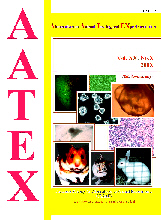All issues

Volume 16 (2011)
- Issue 3 Pages 101-
- Issue 2 Pages 51-
- Issue 1 Pages 1-
Volume 16, Issue 1
Displaying 1-2 of 2 articles from this issue
- |<
- <
- 1
- >
- >|
ORIGINAL ARTICLE
-
Tadashi Uchino, Toshiaki Takezawa, Yoshiaki Ikarashi, Tetsuji Nishimur ...Article type: Original Article
2011 Volume 16 Issue 1 Pages 1-8
Published: June 30, 2011
Released on J-STAGE: December 06, 2011
JOURNAL FREE ACCESSIn order to evaluate water-insoluble chemicals using the skin model which is more similar to real skin and detectable interaction among three kind cells, we established a test method which is a three-dimensional human skin model consisting of normal fibroblasts, normal keratinocytes and normal dendritic cells utilizing a collagen vitrigel membrane (VG-KDF-Skin). Nine sensitizers and five non-sensitizers were then examined. After 24 hr, the amount of IL-1αand IL-4 release was measured, and then positive/negative outcomes were evaluated (VG-KDF-Skin method).
The accuracy, sensitivity and specificity of positive/negative outcomes of the VG-KDF-Skin method, whose indicator is IL-4 release vs. local lymph node assay (LLNA), were 93%, 89% and 100%, respectively. The accuracy, sensitivity and specificity of the VG-KDF-Skin method, whose indicator is IL-1αrelease vs. LLNA, were 50%, 56% and 40%, respectively.
In order to study the possibility of applying an established test method to cosmetic products such as milky lotion and cream, two model cosmetic samples containing a typical skin sensitizer [2,4-dinitrochlorobenzene (DNCB)] were made and IL-4 release evaluated. Significant IL-4 release was induced.
These results suggest that it is possible the VG-KDF-Skin-method using IL-4 as an indicator for skin sensitization potential would be useful for evaluating the skin sensitization potential of chemicals and cosmetic products.View full abstractDownload PDF (425K)
MINI REVIEW
-
Koichi ImaiArticle type: Mini Review
2011 Volume 16 Issue 1 Pages 9-16
Published: June 30, 2011
Released on J-STAGE: December 06, 2011
JOURNAL FREE ACCESSIn 1997. Spielmann et al. developed the embryonic stem cell test (EST), which is an in vitro embryotoxicity test method that can be used to estimate the risk of embryotoxicity of chemical substances relatively quickly compared to the conventional methods that involve animal experiments. The EST has been evaluated in a formal validation study funded by the ECVAM (European Centre for the Validation of Alternative Methods) in which two other in vitro embryotoxicity tests (micro-mass test, whole embryo culture test) were validated against a set of test chemicals characterized by high levels of in vivo embryotoxicity data in laboratory animals and humans. In a validation study in Europe, the EST was found to be reproducible, demonstrating an overall accuracy of 80% and 100% correct prediction of strong embryotoxicity for chemicals studied under blind conditions.
The EST protocol holds promise as a screening assay based on the most important mechanisms in embryotoxicity, cytotoxicity and differentiation, as well on differences in sensitivity between adult and embryonic tissues.View full abstractDownload PDF (122K)
- |<
- <
- 1
- >
- >|